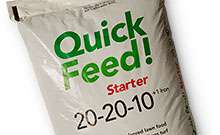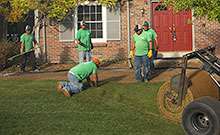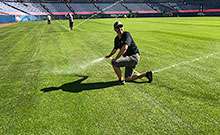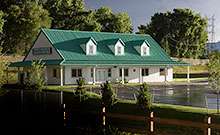
The Environmental Benefits of Using Sod for Landscaping
How Often Should I Water My Sod?
At first, you’ll have to water your newly installed sod daily. Then, you can gradually taper off your watering routine so that you’re giving your new lawn a drink about twice a week. The type of sod will impact how often it needs more moisture than nature can provide. Local climate and weather patterns are other important factors. For customized instructions, see what our sod experts recommend for your property.
Overview of How Often to Water Your Sod
Are you worried about overwatering your sod, causing root rot, or underwatering it, leaving behind dry, brown patches? Fear not, the following guide acts as a cheat sheet on how often you should water your sod:
- Week 1 to Week 2: Newly laid sod needs plenty of water to establish its roots. You should keep the grass and soil moist but not waterlogged. This often means watering it once or twice a day.
- Week 3 to Week 4: Gradually reduce the frequency but increase the duration of watering sessions. This helps keep the soil damp between watering sessions. Getting out the hose every other day will encourage deeper root growth as your lawn starts to build a healthy root system.
- 5 Weeks and Beyond: At this stage, your sod has become more established. Switch to watering it once or twice a week—depending on weather conditions.
How can you tell how often to water your lawn? Including rainfall, your sod needs about one inch of water per week to thrive. Regular maintenance of your sod, whether it’s Kentucky bluegrass or Bermuda grass, includes watering it. Follow our advice on the best ways to keep your yard lush without wasting water.
How to Water Sod for Maximum Effect
Turn on the sprinkler or manually water your lawn in the early morning. The team at Green Valley Turf Company can help you find an affordable system if you want to automate your watering routine. Irrigation systems are more efficient than using the hose and spraying the sod yourself.
Additionally, you can set a timer to complete the task while the sun is down. You won’t even have to wake up early. By watering new sod before the sun comes up, you can conserve water. That’s because less of the moisture will evaporate. You can also water the grass after the sun goes down when you need to water it twice a day.
Watering Tip
Avoid watering too late in the day. If the grass remains wet overnight, it could cause fungal diseases. Additionally, we recommend letting our team do the installation to ensure that your sod has the best chance to thrive. However, you’ll still need to water and maintain your lawn to keep it healthy and beautiful.
Mowing Tips
Many homeowners mow their grass weekly. However, we recommend letting it grow up to 3 or 4 inches during warm, dry weather. During the cool seasons, you can let your grass grow 4 to 6 inches. This allows it to maintain moisture and does not start growth.
Implement a standard fertilizing schedule, such as three to four times a year, and ensure that your fertilizer is high in nitrogen. If you use a slow-release lawn fertilizer, you can count on thick, lush.
FAQs
Can you water new sod too often?
Yes. Aim for moist soil that’s not soggy. Using an irrigation system helps you achieve even moisture levels.
How often should you water newly installed sod?
For the first week, water your new sod twice a day. You’ll need to continue this routine until the root system takes hold.
When does it take new sod to become established?
Most grass species require at least three weeks to root.
Need Help?
Your local turf company has the expertise to answer all your irrigation and maintenance questions. The team at Green Valley Turf Company has developed a reputation for friendly service and customer care.
Are You Interested in Sod Installation in Denver? Contact Green Valley Turf Company
Green Valley Turf Company is your source for sod installation in Denver. Call today to learn more about how we can install a healthy, strong lawn in the Denver area.
The Environmental Benefits of Using Sod for Landscaping
It is common to underestimate the environmental benefits of landscaping with sod, particularly when compared to alternatives such as asphalt, concrete, artificial turf, and some vegetative landscaping. Modern, drought-tolerant hybrids require less watering than grasses of the past and are especially beneficial when combined with landscaping incorporating native plants to minimize runoff.
Perhaps the most widely recognized benefit of sod and lawn grasses is the impact on water runoff. Sod traps rainwater and is particularly effective when trying to establish a lawn in a sloping area. Sod typically withstands full use within weeks of installation because it stays in place and begins establishing its root system immediately, providing pathways for rainwater to soak into the soil and recharge groundwater levels. Sod continues providing this benefit even in winter or when dormant.
Less often appreciated is the impact of modern hybrid grasses and sod bred for their drought tolerance. In addition to absorbing rainwater, they require less water to thrive, so they do not need as frequent or as much watering. By lessening the demand for water resources, modern hybrids generally provide all the benefits of early grass strains while reducing the economic and environmental costs.
Grasses also help clean the air, trapping CO2 while producing oxygen during photosynthesis. Your lawn acts as an air purifier, capturing dust and generating oxygen. You can accelerate the ability of sod to capture carbon and limit its release by mulching rather than bagging and removing the clippings. Mulching returns valuable materials to the soil through decomposition. Mulching also removes the downstream effects of hauling the clippings elsewhere for disposal. Instead, the clippings remain in place and are returned to the soil.
Mulching also enhances microbial activity, which is among the reasons sod and lawns promote biodiversity, particularly when you combine lawn grasses with native grasses, flowers, and shrubs that attract wildlife. A healthy lawn contains a variety of microbes and insects that contribute to the food chain, providing feeding opportunities for birds, small mammals, and other wildlife.
Sod and grass lawns also reduce the temperature around your home, reducing the amount of air conditioning needed. Studies regularly show that grass landscaping can reduce nearby air temperatures by 10 degrees, which is a critical issue in urban areas with higher road, building, and parking lot densities. Similarly, sod and lawns reduce noise pollution, allowing you to enjoy a cooler and quieter atmosphere at home.
Many benefits of sod are the benefits of lawn grasses generally. However, sodding provides additional benefits due to the eco-friendly nature of new hybrids, including their drought tolerance. In addition, sodding enjoys benefits compared to seeding because sod starts delivering the benefits of lawn grasses immediately, particularly for areas in which sloping leads to water runoff. Sod needs less watering and chemical applications than growing your lawn from seed and provides immediate carbon sequestration, atmospheric cooling, and noise reduction. Also, since we can lay sod whenever the ground is not frozen, you can gain its environmental benefits from early spring until late in the fall.
Sod and lawn grasses have clear benefits compared to their alternatives and promote a healthier environment in ways we often underestimate.
Wondering how often you should water newly installed sod? For the first two weeks, water your new sod daily, then gradually reduce to twice a week as it establishes, ensuring it receives about one inch of water weekly for optimal growth.
The best sod for golf courses depends on factors like climate and usage, with popular options including Bentgrass, Bermuda Grass, and Zoysia Grass.
















